Study on the Root Characteristics and Effects on Soil Reinforcement of Slope-Protection Vegetation in the Chinese Loess Plateau
Abstract
:1. Introduction
2. Materials and Methods
2.1. Study Area
2.2. Characteristics of Spatial Distribution of Root Systems
2.3. Geometric Morphological Parameters of Root Systems
2.4. Root Fractal Feature Parameters Parameters
2.5. The Whole-Root-System Vertical Pull-Out Force
2.6. Data Analysis
3. Results
3.1. Spatial Distribution Characteristics of Root Systems of Different Tree Species
3.2. Geometric Characteristics of Root System
3.3. Root Characteristic Fractal Parameters
3.4. Maximum Vertical Pull-Out Force of Root System
4. Discussion
4.1. Differences in Root Architecture among Different Tree Species
4.2. The Impact of Root Configuration on Soil Stability
4.3. Limitations
5. Conclusions
Author Contributions
Funding
Data Availability Statement
Conflicts of Interest
References
- Xing, S.K.; Zhang, G.H.; Zhu, P.Z.; Wang, L.L.; Wang, Z.G.; Wang, C.S. Variation in shear strength of soil-root system under five typical land use types on the Loess Plateau of China. Catena 2023, 222, 13. [Google Scholar] [CrossRef]
- Zhao, F.B.; Ma, S.; Wu, Y.P.; Qiu, L.J.; Wang, W.K.; Lian, Y.Q.; Chen, J. The role of climate change and vegetation greening on evapotranspiration variation in the Yellow River Basin, China. Agric. For. Meteorol. 2022, 316, 14. [Google Scholar] [CrossRef]
- Xing, S.K.; Zhang, G.H.; Zhu, P.Z.; Wang, L.L.; Wang, Z.G.; Wang, C.S. Shear strength of soil-root system under different vegetation restoration modes on the Loess Plateau of China. Soil. Tillage Res. 2023, 228, 12. [Google Scholar] [CrossRef]
- An, S.-S.; Darboux, F.; Cheng, M. Revegetation as an efficient means of increasing soil aggregate stability on the Loess Plateau (China). Geoderma 2013, 209–210, 75–85. [Google Scholar] [CrossRef]
- Alam, S.; Manzur, T.; Borquist, E.; Williams, J.; Rogers, C.; Hall, D.; Patterson, W.B. In-situ assessment of soil-root bonding strength to aid in preventing soil erosion. Soil. Tillage Res. 2021, 213, 8. [Google Scholar] [CrossRef]
- Zhang, S.L.; Zhao, H.B.; Wang, X.Z.; Dong, J.X.; Zhao, P.F.; Yang, F.F.; Chen, X.H. Discrete element modeling and shear properties of the maize stubble-soil complex. Comput. Electron. Agric. 2023, 204, 14. [Google Scholar] [CrossRef]
- Amiri Khaboushan, E.; Emami, H.; Mosaddeghi, M.R.; Astaraei, A.R. Estimation of unsaturated shear strength parameters using easily-available soil properties. Soil Tillage Res. 2018, 184, 118–127. [Google Scholar] [CrossRef]
- Amiri, E.; Emami, H.; Mosaddeghi, M.R.; Astaraei, A.R. Shear strength of an unsaturated loam soil as affected by vetiver and polyacrylamide. Soil Tillage Res. 2019, 194, 104331. [Google Scholar] [CrossRef]
- Meng, S.Y.; Zhao, G.Q.; Yang, Y.Y. Impact of Plant Root Morphology on Rooted-Soil Shear Resistance Using Triaxial Testing. Adv. Civ. Eng. 2020, 2020, 8825828. [Google Scholar] [CrossRef]
- Giadrossich, F.; Schwarz, M.; Cohen, D.; Cislaghi, A.; Vergani, C.; Hubble, T.; Phillips, C. Methods to measure the mechanical behaviour of tree roots: A review. Ecol. Eng. 2017, 109, 256–271. [Google Scholar] [CrossRef]
- Gonzalez-Ollauri, A.; Mickovski, S.B. Plant-soil reinforcement response under different soil hydrological regimes. Geoderma 2017, 285, 141–150. [Google Scholar] [CrossRef]
- Li, Y.; Zhu, X.M.; Tian, J.Y. Effectiveness of plant roots to increase the anti-scourability of soil on the loess plateau. Chin. Sci. Bull. 1991, 36, 2077–2082. [Google Scholar]
- Li, Z.W.; Liu, C.; Dong, Y.T.; Chang, X.F.; Nie, X.D.; Liu, L.; Xiao, H.B. Response of soil organic carbon and nitrogen stocks to soil erosion and land use types in the Loess hilly-gully region of China. Soil. Tillage Res. 2017, 166, 1–9. [Google Scholar] [CrossRef]
- Pallewattha, M.; Indraratna, B.; Heitor, A.; Rujikiatkamjorn, C. Shear strength of a vegetated soil incorporating both root reinforcement and suction. Transp. Geotech. 2019, 18, 72–82. [Google Scholar] [CrossRef]
- Yildiz, A.; Graf, F.; Rickli, C.; Springma, S.M. Determination of the shearing behaviour of root-permeated soils with a large-scale direct shear apparatus. Catena 2018, 166, 98–113. [Google Scholar] [CrossRef]
- Xu, Y.Z.; Guo, Y.Y.; Huang, Z.; Liu, D.Z.; Huang, Q.E.; Tang, H. Study on Cynodon dactylon root system affecting dry-wet cracking behavior and shear strength characteristics of expansive soil. Sci. Rep. 2023, 13, 17. [Google Scholar] [CrossRef] [PubMed]
- Zhao, F.B.; Wu, Y.P.; Yin, X.W.; Alexandrov, G.; Qiu, L.J. Toward Sustainable Revegetation in the Loess Plateau Using Coupled Water and Carbon Management. Engineering 2022, 15, 143–153. [Google Scholar] [CrossRef]
- Zhu, P.Z.; Zhang, G.H.; Zhang, B.J.; Wang, H.X. Variation in soil surface roughness under different land uses in a small watershed on the Loess Plateau, China. Catena 2020, 188, 10. [Google Scholar] [CrossRef]
- Sui, Z.F.; Yi, W.; Lu, Y.A.; Deng, L. Experimental and Numerical Simulation Study on the Shear Strength Characteristics of Magnolia multiflora Root-Soil Composites. Adv. Civ. Eng. 2021, 2021, 6642594. [Google Scholar] [CrossRef]
- Zhu, P.Z.; Zhang, G.H.; Wang, H.X.; Zhang, B.J.; Liu, Y.N. Soil moisture variations in response to precipitation properties and plant communities on steep gully slope on the Loess Plateau. Agric. Water Manag. 2021, 256, 14. [Google Scholar] [CrossRef]
- Wang, B.; Zhang, G.H.; Yang, Y.F.; Li, P.P.; Liu, J.X. Response of soil detachment capacity to plant root and soil properties in typical grasslands on the Loess Plateau. Agric. Ecosyst. Environ. 2018, 266, 68–75. [Google Scholar] [CrossRef]
- Zhu, W.; Zhao, D.H.; Di, N.; Li, D.D.; Zhou, O.; Sun, Y.M.; Jia, L.M.; Xi, B.Y. Matching root water uptake patterns to fine root and soil water distributions. Plant Soil 2024, 495, 499–516. [Google Scholar] [CrossRef]
- Burylo, M.; Dutoit, T.; Rey, F. Species Traits as Practical Tools for Ecological Restoration of Marly Eroded Lands. Restor. Ecol. 2014, 22, 633–640. [Google Scholar] [CrossRef]
- Burylo, M.; Rey, F.; Mathys, N.; Dutoit, T. Plant root traits affecting the resistance of soils to concentrated flow erosion. Earth Surf. Process Landf. 2012, 37, 1463–1470. [Google Scholar] [CrossRef]
- De Baets, S.; Poesen, J. Empirical models for predicting the erosion-reducing effects of plant roots during concentrated flow erosion. Geomorphology 2010, 118, 425–432. [Google Scholar] [CrossRef]
- Faucon, M.P.; Houben, D.; Lambers, H. Plant Functional Traits: Soil and Ecosystem Services. Trends Plant Sci. 2017, 22, 385–394. [Google Scholar] [CrossRef]
- Ma, Z.Q.; Guo, D.L.; Xu, X.L.; Lu, M.Z.; Bardgett, R.D.; Eissenstat, D.M.; McCormack, M.L. Evolutionary history resolves global organization of root functional traits. Nature 2018, 555, 94. [Google Scholar] [CrossRef]
- Du, x.; Jian, J.S.; Du, C.; Dstewart, R. Conservation management decreases surface runoff and soil erosion. Int. Soil. Water Conserv. Res. 2022, 10, 2095–6339. [Google Scholar] [CrossRef]
- Ji, X.D.; Chen, L.H.; Zhang, A. Anchorage properties at the interface between soil and roots with branches. J. For. Res. 2017, 28, 83–93. [Google Scholar] [CrossRef]
- Reubens, B.; Poesen, J.; Danjon, F.; Geudens, G.; Muys, B. The role of fine and coarse roots in shallow slope stability and soil erosion control with a focus on root system architecture: A review. Trees-Struct. Funct. 2007, 21, 385–402. [Google Scholar] [CrossRef]
- Danjon, F.; Reubens, B. Assessing and analyzing 3D architecture of woody root systems, a review of methods and applications in tree and soil stability, resource acquisition and allocation. Plant Soil. 2008, 303, 1–34. [Google Scholar] [CrossRef]
- Zhou, Z.C.; Shangguan, Z.P. Soil anti-scouribility enhanced by plant roots. J. Integr. Plant Biol. 2005, 47, 676–682. [Google Scholar] [CrossRef]
- Helsen, K.; Vannoppen, W.; Honnay, O.; Poesen, J. Both below-ground and above-ground functional traits can help predict levee grassland root length density as a proxy for flow erosion resistance. J. Veg. Sci. 2016, 27, 1254–1263. [Google Scholar] [CrossRef]
- Kervroëdan, L.; Armand, R.; Saunier, M.; Ouvry, J.F.; Faucon, M.P. Plant functional trait effects on runoff to design herbaceous hedges for soil erosion control. Ecol. Eng. 2018, 118, 143–151. [Google Scholar] [CrossRef]
- García-Fayos, P.; Bochet, E.; Cerdá, A. Seed removal susceptibility through soil erosion shapes vegetation composition. Plant Soil. 2010, 334, 289–297. [Google Scholar] [CrossRef]
- Gyssels, G.; Poesen, J.; Bochet, E.; Li, Y. Impact of plant roots on the resistance of soils to erosion by water: A review. Prog. Phys. Geogr. 2005, 29, 189–217. [Google Scholar] [CrossRef]
- Jiao, J.Y.; Zhang, Z.G.; Bai, W.J.; Jia, Y.F.; Wang, N. Assessing the Ecological Success of Restoration by Afforestation on the Chinese Loess Plateau. Restor. Ecol. 2012, 20, 240–249. [Google Scholar] [CrossRef]
- Zhang, D.; Cheng, J.H.; Liu, Y.; Zhang, H.J.; Ma, L.; Mei, X.M.; Sun, Y.H. Spatio-Temporal Dynamic Architecture of Living Brush Mattress: Root System and Soil Shear Strength in Riverbanks. Forests 2018, 9, 493. [Google Scholar] [CrossRef]
- Katuwal, S.; Vermang, J.; Cornelis, W.M.; Gabriels, D.; Moldrup, P.; de Jonge, L.W. Effect of Root Density on Erosion and Erodibility of a Loamy Soil Under Simulated Rain. Soil. Sci. 2013, 178, 29–36. [Google Scholar] [CrossRef]
- Jian, S.Q.; Zhao, C.Y.; Fang, S.M.; Yu, K. Effects of different vegetation restoration on soil water storage and water balance in the Chinese Loess Plateau. Agric. For. Meteorol. 2015, 206, 85–96. [Google Scholar] [CrossRef]
- Yan, H.; Liu, X.L.; Ding, H.; Dai, Z.G.; Niu, X.L.; Zhao, L. Hormonal Balance, Photosynthesis, and Redox Reactions in the Leaves of Caragana korshinskii Kom. under Water Deficit. Plants 2023, 12, 2076. [Google Scholar] [CrossRef] [PubMed]
- He, X.H.; Si, J.H.; Zhu, L.; Zhou, D.M.; Zhao, C.Y.; Jia, B.; Wang, C.L.; Qin, J.; Zhu, X.L. Modeling habitat suitability of Hippophae rhamnoides L. using MaxEnt under climate change in China: A case study of H. r. sinensis and H. r. turkestanica. Front. For. Glob. Change 2023, 5, 1095784. [Google Scholar] [CrossRef]
- Chen, H.; Xiang, Y.; Yao, Z.; Zhang, Q.; Li, H.; Cheng, M. Stability of C:N:P Stoichiometry in the Plant-Soil Continuum along Age Classes in Natural Pinus tabuliformis Carr. Forests of the Eastern Loess Plateau, China. Forests 2023, 14, 44. [Google Scholar] [CrossRef]
- Danjon, F.; Khuder, H.; Stokes, A. Deep phenotyping of coarse root architecture in R. pseudoacacia reveals that tree root system plasticity is confined within its architectural model. PLoS ONE 2013, 8, e83548. [Google Scholar] [CrossRef]
- Tan, J.; Yu, W.; Liu, Y.; Guo, Y.; Liu, N.; Fu, H.; Di, N.; Duan, J.; Li, X.; Xi, B. Response of fine-root traits of Populus tomentosa to drought in shallow and deep soil. Forests 2023, 14, 951. [Google Scholar] [CrossRef]
- Li, Y.G.; Dong, X.X.; Yao, W.X. C, N, P, K stoichiometric characteristics of the “leaf-root-litter-soil’’ system in dryland plantations. Ecol. Indic. 2022, 143, 109371. [Google Scholar] [CrossRef]
- Zuo, X.A.; Zhao, X.Y.; Zhao, H.L.; Zhang, T.H.; Guo, Y.R.; Li, Y.Q.; Huang, Y.X. Spatial heterogeneity of soil properties and vegetation-soil relationships following vegetation restoration of mobile dunes in Horqin Sandy Land, Northern China. Plant Soil 2009, 318, 153–167. [Google Scholar] [CrossRef]
- Pollen, N.; Simon, A. Estimating the mechanical effects of riparian vegetation on stream bank stability using a fiber bundle model. Water Resour. Res. 2005, 41, 11. [Google Scholar] [CrossRef]
- Prieto, I.; Roumet, C.; Cardinael, R.; Dupraz, C.; Jourdan, C.; Kim, J.H.; Maeght, J.L. Root functional parameters along a land-use gradient: Evidence of a community-level economics spectrum. J. Ecol. 2015, 103, 361–373. [Google Scholar] [CrossRef]
- Chen, A.Q.; Zhang, D.; Peng, H.; Fan, J.R.; Xiong, D.H.; Liu, G.C. Experimental study on the development of collapse of overhanging layers of gully in Yuanmou Valley, China. Catena 2013, 109, 177–185. [Google Scholar] [CrossRef]
- Guo, M.M.; Wang, W.L.; Kang, H.L.; Yang, B. Changes in soil properties and erodibility of gully heads induced by vegetation restoration on the Loess Plateau, China. J. Arid. Land. 2018, 10, 712–725. [Google Scholar] [CrossRef]
- Guo, M.M.; Wang, W.L.; Shi, Q.H.; Chen, T.D.; Kang, H.L.; Li, J.M. An experimental study on the effects of grass root density on gully headcut erosion in the gully region of China’s Loess Plateau. Land. Degrad. Dev. 2019, 30, 2107–2125. [Google Scholar] [CrossRef]
- Ran, Q.H.; Su, D.Y.; Li, P.; He, Z.G. Experimental study of the impact of rainfall characteristics on runoff generation and soil erosion. J. Hydrol. 2012, 424, 99–111. [Google Scholar] [CrossRef]
- Rieke-Zapp, D.H.; Nichols, M.H. Headcut retreat in a semiarid watershed in the southwestern United States since 1935. Catena 2011, 87, 1–10. [Google Scholar] [CrossRef]
- Su, Z.A.; Xiong, D.H.; Dong, Y.F.; Li, J.J.; Yang, D.; Zhang, J.H.; He, G.X. Simulated headward erosion of bank gullies in the Dry-hot Valley Region of southwest China. Geomorphology 2014, 204, 532–541. [Google Scholar] [CrossRef]
- Tao, W.H.; Wu, J.H.; Wang, Q.J. Mathematical model of sediment and solute transport along slope land in different rainfall pattern conditions. Sci. Rep. 2017, 7, 11. [Google Scholar] [CrossRef]
- Osman, N.; Barakbah, S.S. Parameters to predict slope stability—Soil water and root profiles. Ecol. Eng. 2006, 28, 90–95. [Google Scholar] [CrossRef]
- Wang, H.; Zhao, Z.M.; He, L. Experimental research on soil reinforcement of different plant tree types. Railw. Eng. 2009, 11, 61–63. [Google Scholar]
- Hao, S.W.; Su, J.; Yang, Y.H. A fractal method of estimating soil structure changes under different vegetations on Ziwuling Mountains of the Loess Plateau, China. Agric. Sci. China 2006, 5, 530–538. [Google Scholar]
- Zuo, D.P.; Xu, Z.X.; Yao, W.Y.; Jin, S.Y.; Xiao, P.Q.; Ran, D.C. Assessing the effects of changes in land use and climate on runoff and sediment yields from a watershed in the Loess Plateau of China. Sci. Total Environ. 2016, 544, 238–250. [Google Scholar] [CrossRef] [PubMed]

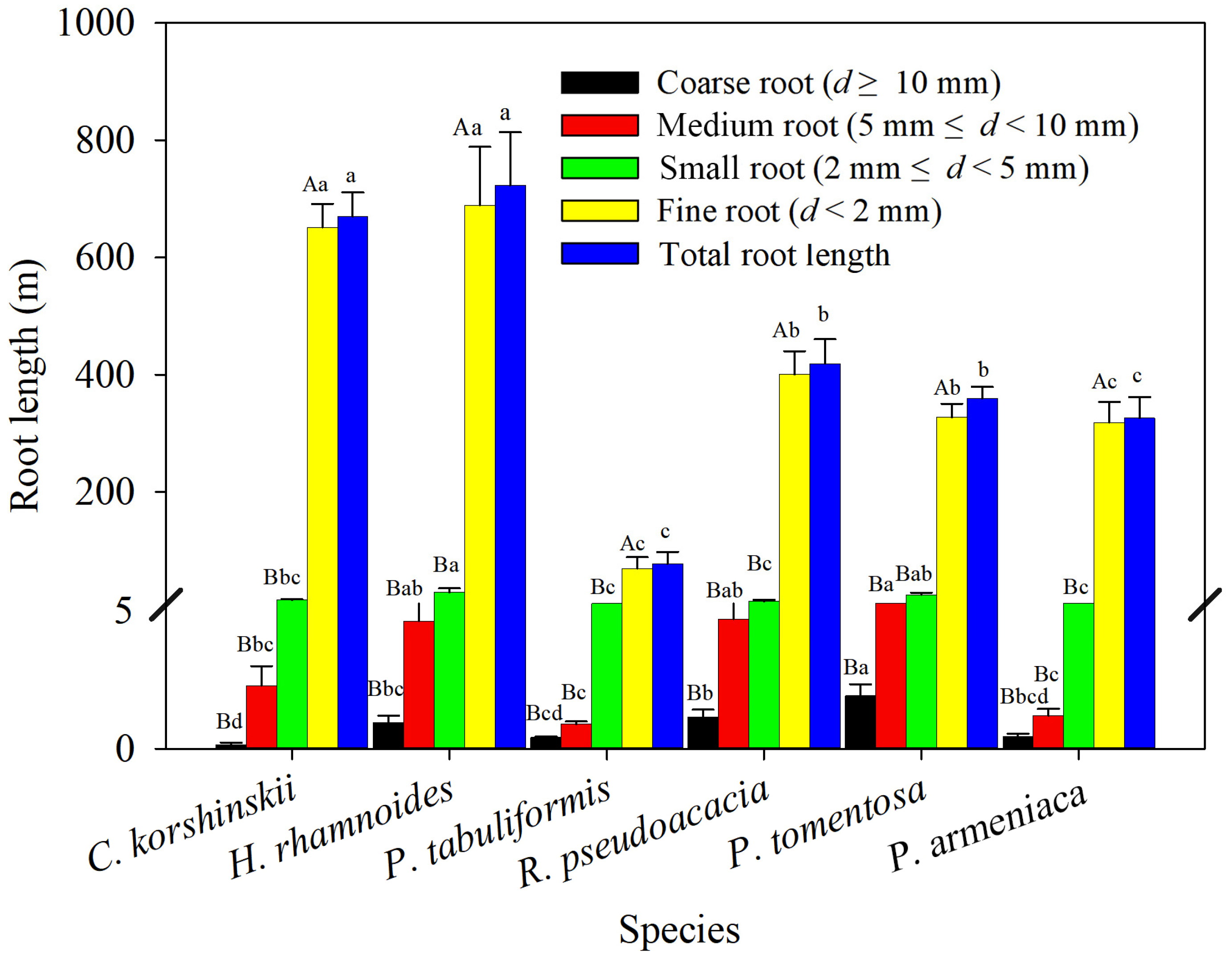
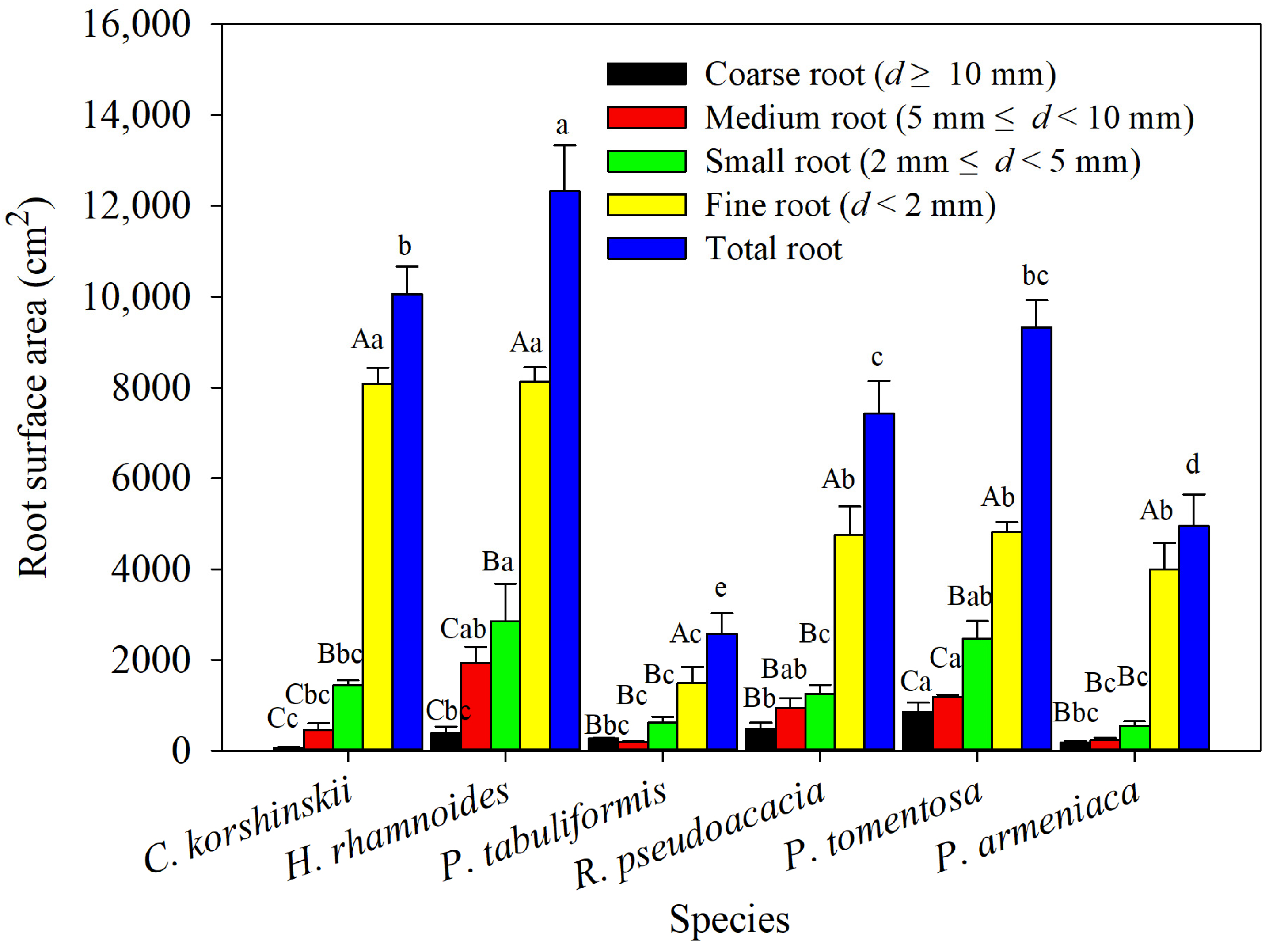
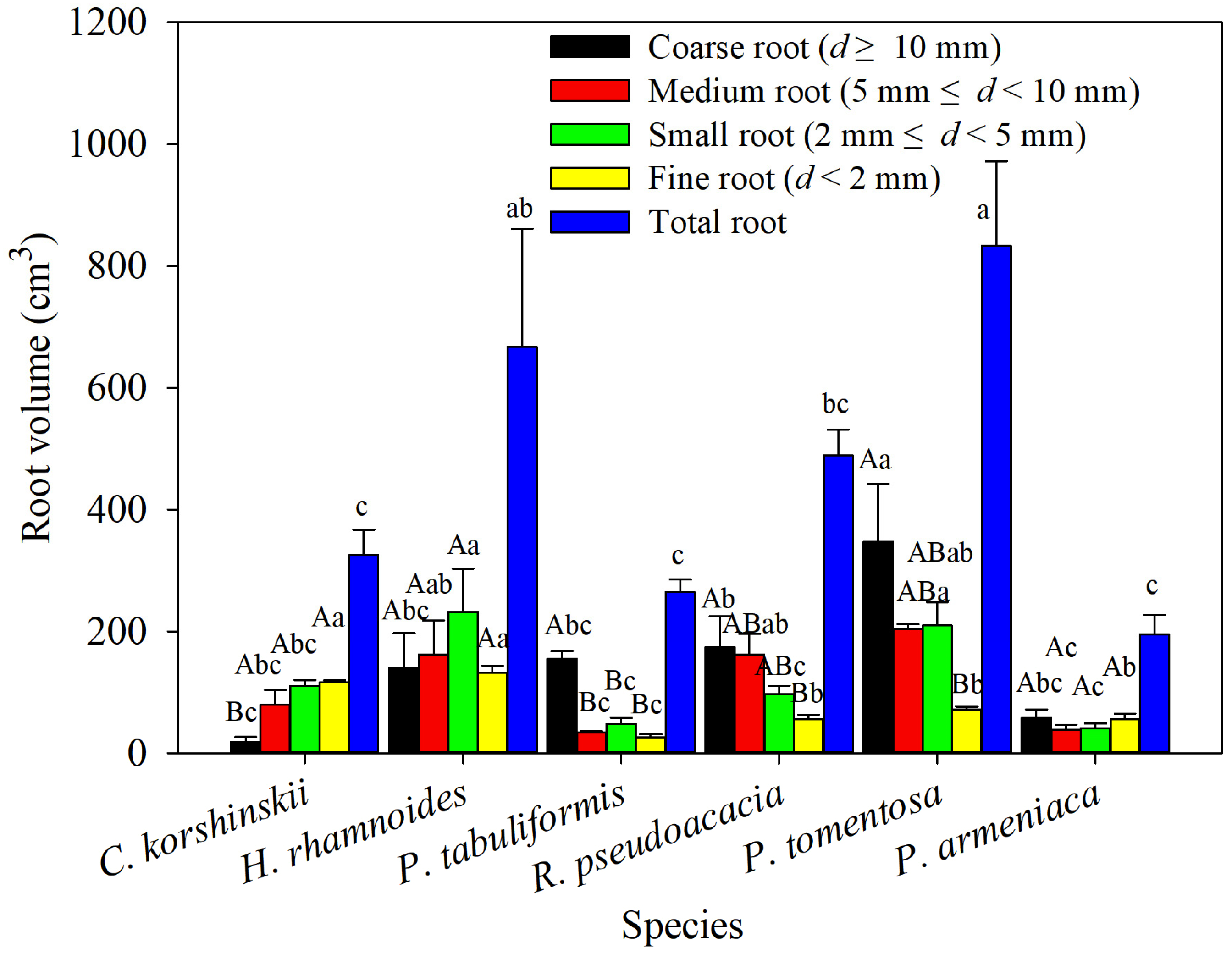

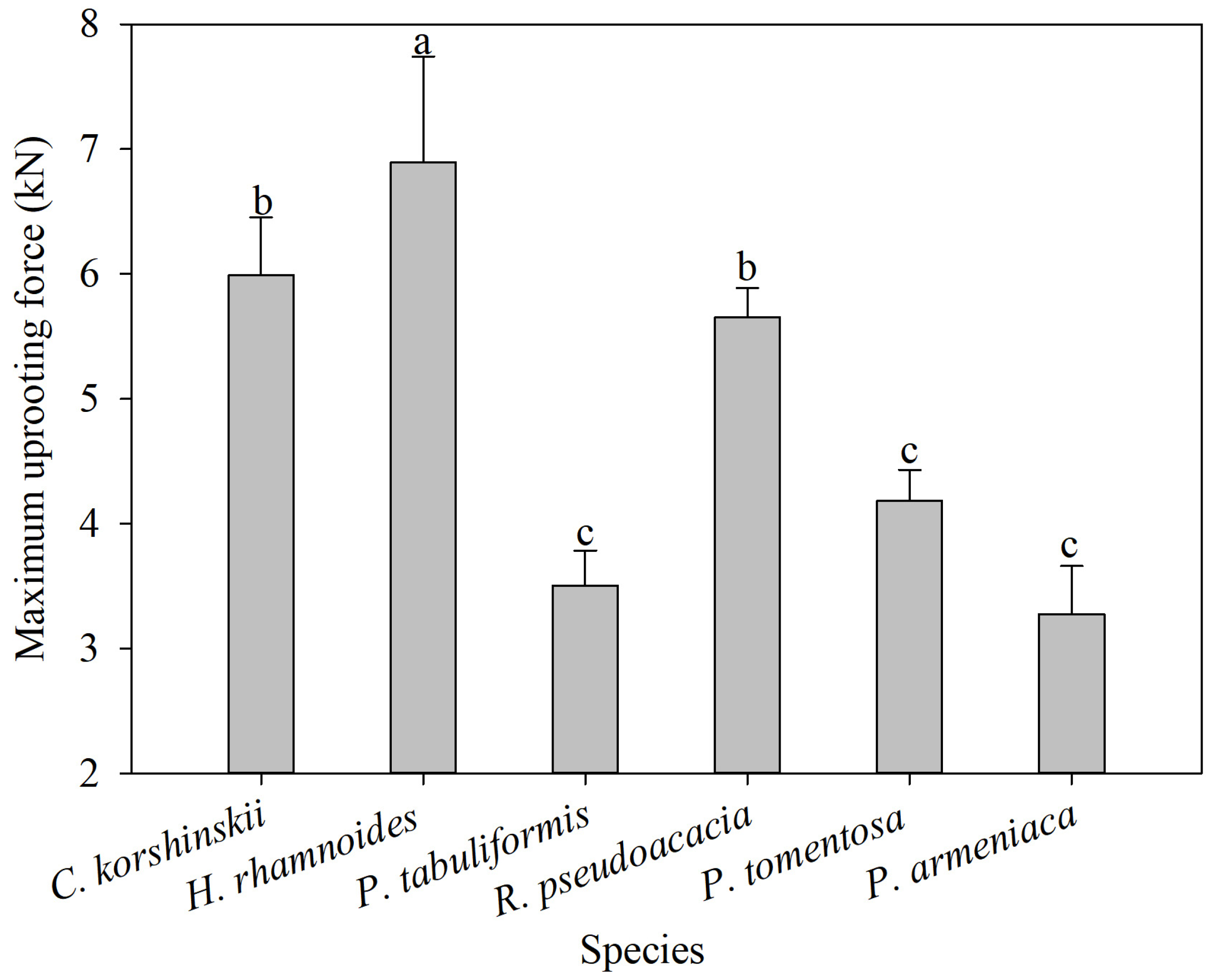
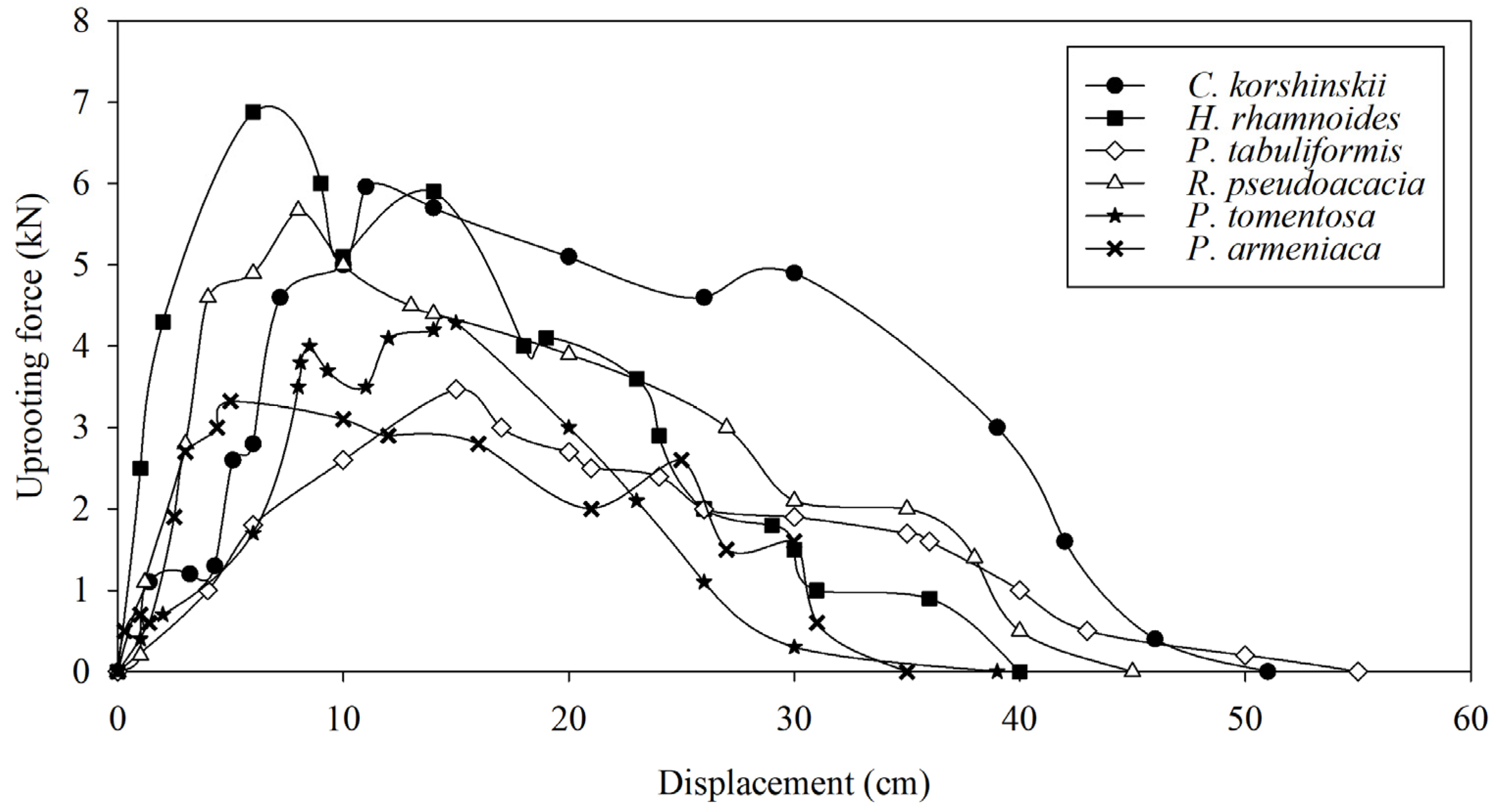
| Categories | Parameters | Sample Numbers | Mean ± SD | |||||
|---|---|---|---|---|---|---|---|---|
| C. Korshinskii | H. rhamnoides | P. tabuliformis | R. pseudoacacia | P. tomentosa | P. armeniaca | |||
| Geographical parameters | Slope aspect | -- | SE | NE | NE | NE | SE | SE |
| Slope position | -- | Middle | Upper | Middle | Middle | Down | Upper | |
| Slope gradient (°) | -- | 5 | 9 | 10 | 12 | 8 | 13 | |
| Biological parameters | Plant height (m) | 3 | 1.8 ± 0.2 | 2.3 ± 0.3 | 12 ± 0.7 | 8 ± 0.5 | 14 ± 0.6 | 5 ± 0.4 |
| Canopy width (cm) | 3 | 190 ± 16 | 201 ± 20 | 350 ± 21 | 226 ± 19 | 280 ± 21 | 5.1 ± 0.5 | |
| DBH/BD (cm) | 3 | 4.1 ± 0.5 | 5.3 ± 0.3 | 12.3 ± 1.6 | 9.1 ± 1.2 | 15.6 ± 1.3 | 7.2 ± 0.6 | |
| Age | -- | 27 | 27 | 25 | 25 | 19 | 15 | |
| Soil parameters (Top 1 m) | Clay (<0.002 mm; %) | 12 | 9.17 ± 1.1 | 11.04 ± 2.2 | 9.45 ± 2.32 | 10.22 ± 1.47 | 10.24 ± 1.36 | 11.64 ± 2.31 |
| Silt (0.05–0.002 mm; %) | 12 | 75.59 ± 9.31 | 76.69 ± 12.15 | 75.46 ± 10.04 | 77.36 ± 10.31 | 75.36 ± 10.54 | 76.19 ± 11.24 | |
| Sand (0.05–2 mm; %) | 12 | 15.24 ± 1.23 | 12.27 ± 2.93 | 15.09 ± 1.16 | 12.42 ± 2.11 | 14.4 ± 2.05 | 12.17 ± 1.63 | |
| Organic matter (%) | 12 | 0.74 ± 0.09 | 0.72 ± 0.05 | 0.87 ± 0.09 | 0.94 ± 0.08 | 0.73 ± 0.05 | 0.86 ± 0.04 | |
| pH | 12 | 8.0 ± 0.9 | 7.9 ± 0.8 | 8.2 ± 0.4 | 8.1 ± 0.4 | 8.1 ± 0.5 | 7.9 ± 0.4 | |
| Soil bulk density (g cm−3) | 12 | 1.13 ± 0.23 | 1.25 ± 0.21 | 1.33 ± 0.13 | 1.28 ± 0.16 | 1.29 ± 0.15 | 1.24 ± 0.17 | |
| Tree Species | Rha (m) | Rd (m) | Rwdr | Nhr (Ind·Plant−1) | Nir (Ind·Plant−1) | Nvr (Ind·Plant−1) | Tnr (Ind·Plant−1) |
|---|---|---|---|---|---|---|---|
| CK | 1.73 ± 0.26 ab | 1.23 ± 0.03 cd | 2.12 ± 0.38 b | 27.52 ± 2.79 Aa | 5.00 ± 0.26 Bbc | 3.00 ± 0.87 Bb | 35.54 ± 4.05 a |
| HR | 1.50 ± 0.12 b | 1.91 ± 0.03 a | 1.19 ± 0.11 c | 2.51 ± 1.01 Bc | 12.51 ± 3.60 Aa | 4.01 ± 1.32 Bb | 19.02 ± 3.29 cd |
| PT | 1.53 ± 0.06 b | 1.53 ± 0.12 b | 1.52 ± 0.14 bc | 23.02 ± 3.50 Aa | 1.01 ± 0.50 Bc | 1.50 ± 0.03 Bb | 25.53 ± 3.98 bc |
| RP | 1.71 ± 0.23 ab | 1.35 ± 0.02 bc | 1.91 ± 0.23 bc | 15.51 ± 0.45 Ab | 8.51 ± 13.2 Bab | 7.01 ± 1.32 Ba | 31.04 ± 1.80 ab |
| PTA | 2.21 ± 0.23 a | 1.02 ± 0.05 d | 3.24 ± 0.38 a | 10.02 ± 1.32 Ab | 4.50 ± 0.87 Bab | 1.50 ± 0.05 Ba | 16.02 ± 2.00 ab |
| PA | 1.41 ± 0.03 b | 1.11 ± 0.12 d | 1.52 ± 0.14 bc | 23.02 ± 3.50 Aa | 1.01 ± 0.5 Bc | 1.50 ± 0.02 Bb | 25.53 ± 3.98 bc |
| Uprooting Force | Total-Root Length | Total-Root Surface Area | Total-Root Volume | Fractal Dimension | Fractal Abundance | Root Width-Depth Ratio | Number of Horizontal Roots | Number of Inclined Roots | Number of Vertical Roots | |
|---|---|---|---|---|---|---|---|---|---|---|
| Total-root length | 0.927 * | |||||||||
| Total-root surface area | 0.887 * | 0.971 ** | ||||||||
| Total-root volume | 0.434 | 0.361 | 0.731 | |||||||
| Fractal dimension | 0.769 | 0.942 * | 0.984 ** | 0.664 | ||||||
| Fractal abundance | 0.766 | 0.994 * | 0.975 ** | 0.666 | 0.999 ** | |||||
| Root width–depth ratio | −0.432 | 0.142 | 0.107 | 0.483 | 0.216 | 0.220 | ||||
| Number of horizontal roots | 0.115 | −0.254 | −0.411 | −0.588 | −0.453 | −0.465 | 0.061 | |||
| Number of inclined roots | 0.960 * | 0.844 | 0.874 | 0.600 | 0.805 | 0.813 | −0.362 | −0.595 | ||
| Number of vertical roots | 0.715 | 0.439 | 0.362 | 0.182 | 0.341 | 0.365 | −0.318 | −0.072 | 0.756 | |
| Total number of roots | 0.474 | 0.246 | 0.073 | −0.288 | −0.009 | −0.012 | −0.189 | −0.857 | 0.081 | 0.560 |
Disclaimer/Publisher’s Note: The statements, opinions and data contained in all publications are solely those of the individual author(s) and contributor(s) and not of MDPI and/or the editor(s). MDPI and/or the editor(s) disclaim responsibility for any injury to people or property resulting from any ideas, methods, instructions or products referred to in the content. |
© 2024 by the authors. Licensee MDPI, Basel, Switzerland. This article is an open access article distributed under the terms and conditions of the Creative Commons Attribution (CC BY) license (https://creativecommons.org/licenses/by/4.0/).
Share and Cite
Zhang, X.; Fu, Y.; Pei, Q.; Guo, J.; Jian, S. Study on the Root Characteristics and Effects on Soil Reinforcement of Slope-Protection Vegetation in the Chinese Loess Plateau. Forests 2024, 15, 464. https://doi.org/10.3390/f15030464
Zhang X, Fu Y, Pei Q, Guo J, Jian S. Study on the Root Characteristics and Effects on Soil Reinforcement of Slope-Protection Vegetation in the Chinese Loess Plateau. Forests. 2024; 15(3):464. https://doi.org/10.3390/f15030464
Chicago/Turabian StyleZhang, Xueli, Yimin Fu, Qinghao Pei, Jinjun Guo, and Shengqi Jian. 2024. "Study on the Root Characteristics and Effects on Soil Reinforcement of Slope-Protection Vegetation in the Chinese Loess Plateau" Forests 15, no. 3: 464. https://doi.org/10.3390/f15030464
APA StyleZhang, X., Fu, Y., Pei, Q., Guo, J., & Jian, S. (2024). Study on the Root Characteristics and Effects on Soil Reinforcement of Slope-Protection Vegetation in the Chinese Loess Plateau. Forests, 15(3), 464. https://doi.org/10.3390/f15030464





